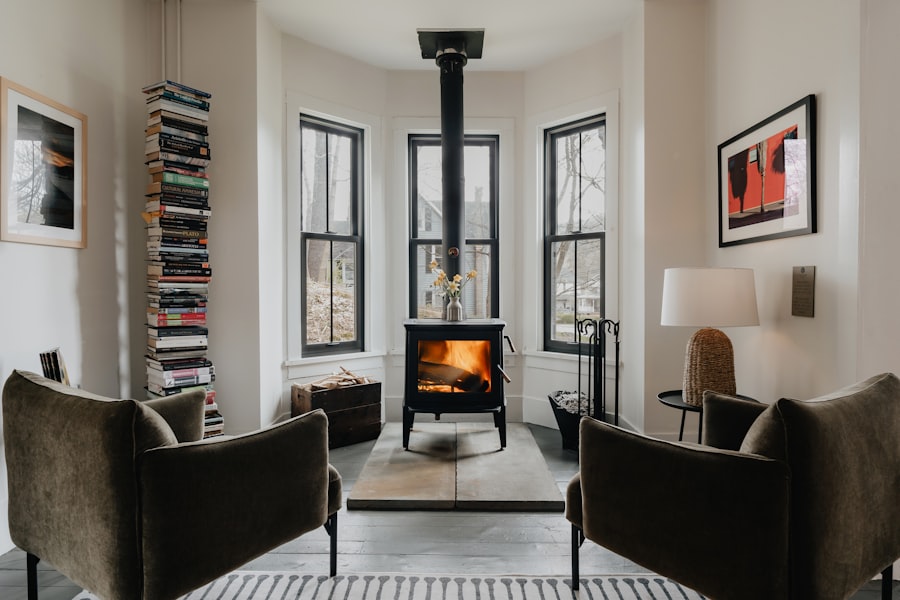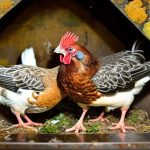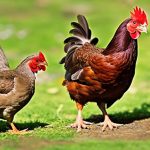Insulating a chicken coop is crucial for maintaining optimal temperature and promoting the health of chickens, particularly during colder seasons. Effective insulation regulates internal coop temperature, creating a warm environment for the flock. Common insulation materials include foam board, fiberglass, and recycled denim, which can be applied to walls, ceilings, and floors to create a thermal barrier.
Sealing gaps and cracks with caulk or weather-stripping further prevents heat loss and drafts. Natural materials such as straw or hay offer an alternative insulation method. These can be used to line coop walls and floors, providing additional warmth and insulation.
However, it’s essential to regularly replace these materials to maintain dryness and cleanliness, as damp bedding can counteract insulation efforts and potentially lower coop temperature. Proper insulation techniques help ensure chicken comfort and well-being throughout colder periods, contributing to overall flock health and productivity. By implementing these insulation strategies, chicken owners can create a more stable and suitable environment for their birds year-round.
Table of Contents
- 1 Provide Adequate Ventilation
- 2 Use Deep Litter Method
- 3 Install a Heat Lamp
- 4 Offer Warm Water and Nutritious Food
- 5 Consider Using Sweaters or Coats for Chickens
- 6 Monitor the Health and Behavior of the Chickens
- 7 FAQs
- 7.1 What are the best ways to keep chickens warm in winter?
- 7.2 How can I insulate my chicken coop for winter?
- 7.3 What temperature is too cold for chickens?
- 7.4 Are there any specific breeds of chickens that are better suited for cold weather?
- 7.5 Should I use a heat lamp in my chicken coop during winter?
Key Takeaways
- Insulate the coop to keep the chickens warm during cold weather
- Provide adequate ventilation to prevent moisture buildup and maintain air quality
- Use the deep litter method to create natural insulation and warmth
- Install a heat lamp to provide additional warmth during extreme cold
- Offer warm water and nutritious food to help chickens maintain their body temperature
- Consider using sweaters or coats for chickens for added warmth
- Monitor the health and behavior of the chickens regularly to ensure they are coping well with the cold conditions
Provide Adequate Ventilation
Why Ventilation Matters
Proper ventilation is essential for maintaining a healthy environment in the chicken coop. Without it, the buildup of moisture, ammonia, and other pollutants can lead to respiratory issues and other health problems for the chickens.
Installing Vents and Windows
One way to provide ventilation in the coop is by installing windows or vents that can be opened and closed as needed. This allows for fresh air to circulate through the coop while still maintaining a comfortable temperature for the chickens. It’s important to position the vents or windows in a way that prevents drafts from directly hitting the chickens, as this can cause them to become chilled.
The Benefits of Good Ventilation
By providing adequate ventilation in the coop, you can help to ensure that your chickens stay healthy and comfortable throughout the winter. Good ventilation helps to remove pollutants, regulate temperature, and prevent the buildup of moisture, all of which are essential for maintaining a healthy and happy flock.
Use Deep Litter Method

The deep litter method is a popular technique for managing chicken coop bedding, especially during the winter months. This method involves adding a thick layer of bedding material, such as straw, wood shavings, or shredded paper, to the floor of the coop and allowing it to build up over time. As the chickens scratch and peck at the bedding, it becomes mixed with their droppings and other organic matter, creating a natural composting process that generates heat.
The deep litter method not only helps to keep the chickens warm by generating heat as the bedding decomposes, but it also provides a soft and comfortable surface for them to walk and rest on. Additionally, the composting process helps to break down odors and reduce ammonia levels in the coop, creating a healthier environment for the chickens. It’s important to regularly turn and fluff the bedding to promote airflow and prevent it from becoming compacted.
By using the deep litter method in the chicken coop, you can help to maintain a cozy and healthy environment for your flock during the winter.
Install a Heat Lamp
In some cases, especially in extremely cold climates, installing a heat lamp in the chicken coop can provide additional warmth for your flock during the winter months. A heat lamp can be hung from the ceiling of the coop and directed towards a specific area where the chickens roost or gather. It’s important to use a heat lamp specifically designed for use in a chicken coop, as these lamps are equipped with safety features such as a wire guard to prevent accidental contact with the bulb.
When using a heat lamp in the chicken coop, it’s crucial to monitor it regularly to ensure that it is functioning properly and not posing a fire hazard. Additionally, it’s important to position the heat lamp in a way that prevents direct contact with the chickens, as they can be at risk of burns or overheating. While a heat lamp can provide additional warmth for your flock, it should be used as a supplemental heating source and not as a primary means of keeping the coop warm.
By installing a heat lamp in the chicken coop, you can help to provide extra comfort and warmth for your chickens during the winter.
Offer Warm Water and Nutritious Food
During the winter months, it’s important to ensure that your chickens have access to warm water and nutritious food to help them stay healthy and maintain their body temperature. Cold water can cause chickens to become chilled, so it’s essential to provide them with fresh, warm water throughout the day. One way to keep their water from freezing is by using heated waterers or adding warm water to their drinking containers several times a day.
In addition to warm water, providing your chickens with nutritious food is crucial for helping them stay warm and healthy during the winter. A diet rich in protein and essential nutrients can help to support their immune system and maintain their energy levels. Consider supplementing their regular feed with treats such as mealworms, cracked corn, or black oil sunflower seeds, which are high in protein and fat content.
Additionally, providing access to fresh fruits and vegetables can help to keep your chickens healthy and hydrated during the winter months.
Consider Using Sweaters or Coats for Chickens

Why Chicken Sweaters Can Be Beneficial
For some chicken owners, especially those with smaller or more delicate breeds, using sweaters or coats for chickens can provide an extra layer of warmth during the winter months. Chicken sweaters are typically made from soft, stretchy fabric and are designed to fit snugly around the chicken’s body, providing insulation and protection from the cold. While not all chickens may need sweaters or coats, they can be particularly beneficial for older or more vulnerable birds.
Choosing the Right Sweater or Coat
When choosing a sweater or coat for your chickens, it’s important to select one that fits properly without restricting their movement or causing discomfort. Additionally, it’s crucial to monitor your chickens while they are wearing sweaters or coats to ensure that they are not becoming tangled or overheated. If you notice any signs of distress or discomfort, it’s best to remove the sweater or coat immediately.
Providing Extra Care and Protection
By considering using sweaters or coats for your chickens, you can provide them with an extra layer of warmth and protection during the winter months.
Monitor the Health and Behavior of the Chickens
During the winter months, it’s essential to closely monitor the health and behavior of your chickens to ensure that they are coping well with the cold weather. Keep an eye out for any signs of illness or distress, such as lethargy, decreased appetite, or unusual behavior. Additionally, regularly inspect their feet and combs for signs of frostbite, which can occur in extremely cold temperatures.
It’s also important to observe how your chickens are interacting with each other and their environment. If you notice any signs of aggression or bullying within the flock, it may be necessary to make adjustments to their living conditions to ensure that all of the chickens are able to stay warm and comfortable. By monitoring the health and behavior of your chickens throughout the winter, you can quickly address any issues that arise and ensure that they are able to thrive in their environment.
In conclusion, keeping chickens warm during the winter months requires careful attention to their living conditions and well-being. By insulating the coop, providing adequate ventilation, using the deep litter method, installing a heat lamp, offering warm water and nutritious food, considering using sweaters or coats for chickens, and monitoring their health and behavior, you can help to ensure that your flock stays healthy and comfortable throughout the winter. With proper care and attention, your chickens can continue to thrive even in cold weather conditions.
If you’re looking for more information on keeping chickens warm in winter, you might want to check out this article on where to put your chicken coop. It offers valuable tips on the best location for your coop to ensure your chickens stay cozy during the colder months.
FAQs
What are the best ways to keep chickens warm in winter?
Some of the best ways to keep chickens warm in winter include providing a well-insulated coop, using heat lamps or heated pads, and ensuring good ventilation while avoiding drafts.
How can I insulate my chicken coop for winter?
You can insulate your chicken coop for winter by adding extra bedding, sealing any drafts, and using insulating materials such as foam board or straw bales.
What temperature is too cold for chickens?
Chickens can tolerate cold temperatures, but it’s generally recommended to provide supplemental heat if the temperature drops below 20°F (-6°C) to ensure their comfort and well-being.
Are there any specific breeds of chickens that are better suited for cold weather?
Yes, some chicken breeds are better suited for cold weather, such as the Ameraucana, Orpington, and Wyandotte, which have thick feathers and are more cold-hardy.
Should I use a heat lamp in my chicken coop during winter?
Using a heat lamp in the chicken coop during winter can be beneficial, but it’s important to use it safely and ensure that it doesn’t pose a fire hazard or overheat the coop.
Meet Walter, the feathered-friend fanatic of Florida! Nestled in the sunshine state, Walter struts through life with his feathered companions, clucking his way to happiness. With a coop that’s fancier than a five-star hotel, he’s the Don Juan of the chicken world. When he’s not teaching his hens to do the cha-cha, you’ll find him in a heated debate with his prized rooster, Sir Clucks-a-Lot. Walter’s poultry passion is no yolk; he’s the sunny-side-up guy you never knew you needed in your flock of friends!







